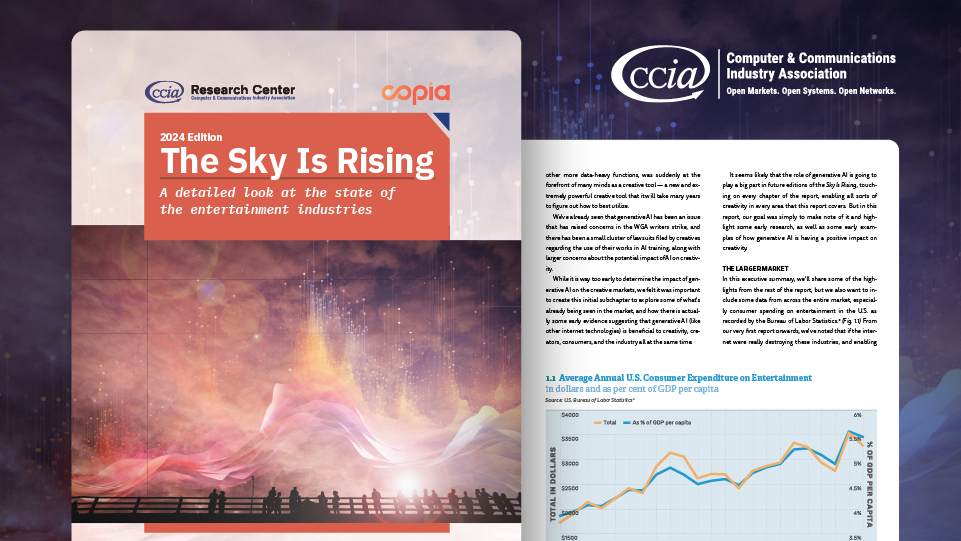2013 Brought Major Fair Use Wins for Tech, Entertainment
The Oracle v. Google case goes before the Federal Circuit on appeal today (stay tuned for a first take of the oral argument here on DisCo). Although the specific issue on appeal is the copyrightability of APIs, the question of copyright fair use has figured prominently in that dispute, as well as numerous other significant copyright cases this year. In fact, 2013 has shaped up to be an important year for fair use and Section 107 of the U.S. Copyright Act, with both tech sector and entertainment industry constituencies scoring impressive fair use wins. Arguably, these victories have strengthened the doctrine.
On the tech side, victors have included the DISH Hopper and Google. Film and theatre litigants have prevailed in prominent fair use defenses as well — inconveniently timed, it turns out, as motion picture industry interests have actively resisted the fair use doctrine in Australia even as it is being successfully invoked in U.S. courts. This post provides a chronological review of some of the more significant fair use decisions in 2013.
The Year in Fair Use
In a March decision that may have set the tone for the year, SOFA Entertainment v. Dodger Productions, 709 F.3d 1273 (9th Cir. 2013), the Ninth Circuit demolished the plaintiff’s arguments in a case involving a 7-second clip from a 1966 episode of The Ed Sullivan Show. The clip, which depicts Ed Sullivan introducing the Four Seasons musical act, was used in the Broadway musical about the Four Seasons, Jersey Boys. SOFA Entertainment, who owned rights to the show, sued the musical production company Dodger over the seven-second use.
Quoting and citing several Supreme Court decisions, the Ninth Circuit summarized fair use thusly:
The Copyright Act exists “‘to stimulate artistic creativity for the general public good.’” It does so by granting authors a “special reward” in the form of a limited monopoly over their works. However, an overzealous monopolist can use his copyright to stamp out the very creativity that the Act seeks to ignite. To avoid that perverse result, Congress codified the doctrine of fair use.
Characterizing the SOFA-Dodger dispute as “a good example of why the ‘fair use’ doctrine exists,” the court accused the litigation of “having a chilling effect on creativity”. It upheld the district court’s decision ordering the plaintiff SOFA to pay the defendant’s legal fees.
April brought another watershed fair use decision in the form of Cariou v. Prince, 714 F.3d 694 (2d Cir. 2013). Well-known “appropriation” artist Richard Prince was sued by Patrick Cariou, a photographer, after Prince repurposed Cariou’s published photography book into various collages. The court definitely rejected Cariou’s argument that a use must “comment upon” an existing work in order to be fair under Section 107, provided that the new use is transformative.
In another entertainment case that DisCo covered [1] [2], Sony Pictures prevailed in July in a trial court over the Faulkner estate, which sued Sony over a Woody Allen film paraphrasing nine words of Faulkner without a license. Faulkner Literary Rights v. Sony Pictures Classics, (N.D. Miss. July 18, 2013). My contention was that this case was wrongly decided. Sony Pictures should not have had to rely on fair use at all, since nine words was too short a selection to qualify for copyright protection in the first place. The court, however, concluded Sony Pictures’ use was fair.
July also brought Fox Broadcasting Co. v. DISH Network (9th Cir. 2013), the first of several victories by direct-broadcast satellite service provider DISH over infringement claims brought by television networks. (DisCo coverage here: [1], [2], [3].) Fox brought suit over DISH’s “PrimeTime Anytime” feature in its Hopper DVR, which enables consumers to record primetime content on the four major broadcast networks, and “AutoHop”, the Hopper’s commercial skipping feature. The Ninth Circuit held that the venerable Sony Betamax case governed, and to the extent it did not, “commercial-skipping does not implicate any copyright interest.” Both CBS and Fox struck out in other litigation against the Hopper, later in the year.
At the end of July, a magistrate held in American Institute of Physics v. Schwegman Lundberg & Woessner, P.A. (D. Minn. 2013) that copying scientific articles for purposes of prosecuting patents before the U.S. Patent & Trademark Office (generally, to document prior art) was fair use. That ruling — closely watched by some patent practitioners — is unpacked by Prof. Rebecca Tushnet here.
In early August, the Ninth Circuit decided another fair use case in favor of the defendant — Seltzer v. Green Day, Inc. (9th Cir. 2013). Heard on the same day the SOFA case was argued, Seltzer involved the music act Green Day’s use of a single, unlicensed image in a multimedia display accompanying live performances. The court concluded that Green Day’s use changed the meaning of the underlying work, and was transformative. It also found the use was “not overly commercial” and had no effect on “the value of the piece or of Seltzer’s artwork in general.” The court therefore ruled in favor of the defendant Green Day. Unlike SOFA Entertainment, however, in which the court excoriated the plaintiff, the Ninth Circuit overturned an award of fees to the defendant Green Day since plaintiff Seltzer’s decision to sue was not objectively unreasonable.
(In another calendar coincidence, the “Lovelace” decision was rendered on the same day as Seltzer. The “Lovelace” dispute – still ongoing – began with an unsuccessful attempt to enjoin the Weinstein Co. biopic about actress Linda Lovelace, star of the cult porn classic, “Deep Throat.” Somewhat similar to the facts of SOFA Entertainment, “Lovelace” included 5 unlicensed minutes of the original “Deep Throat” — in order to advance its narrative. Few details are available on this case, as the transcript of the relevant hearing has not yet been released.)
What may have been one of the most anticipated fair use decisions of the year did not come until mid-November. On November 14, Judge Chin ruled on the long-awaited Google Books case, issuing an impressive win for the search provider. The dispute involved Google’s project to scan the collections of numerous academic libraries and provide users short snippet results in response to search queries. Characterized by commentators as ‘hugely significant’ and ‘remarkable’, Judge Chin’s ruling went out of the way to characterize the full-search functionality resulting from book scanning as an “invaluable research tool”. Although plaintiffs in the case have already indicated plans to appeal, the decision nevertheless represents a significant milestone in fair use jurisprudence.
[Edit: Prof. Eric Goldman explains here why Judge Chin’s ruling in The Authors Guild v. Google is, and is not, a big deal.]
[Edit 2, 12/18/2013: See our discussion of the Dec. 17 Baltimore Ravens/NFL victory in the Bouchat case, another substantial victory for a fair use defendant, decided after this post was first published.]








